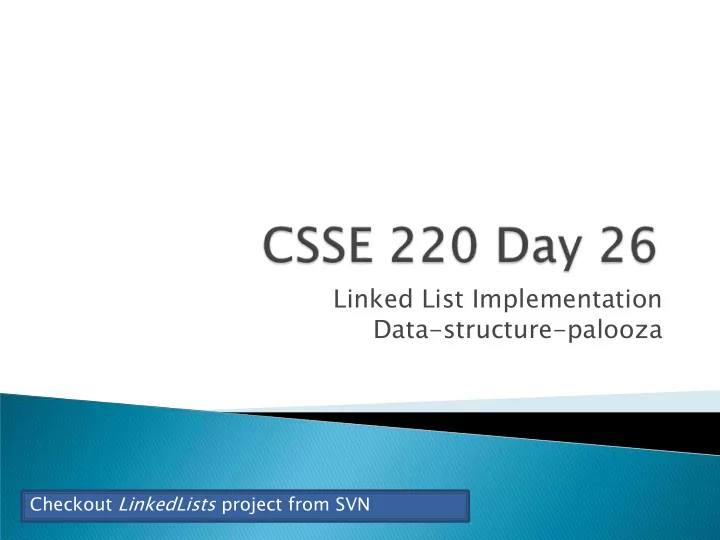

Linked List Implementation Data-structure-palooza Checkout LinkedLists project from SVN
Understanding the engineering trade-offs when storing data
Efficient ways to store data based on how we’ll use it The main theme for the rest of the course So far we’ve seen ArrayList s ◦ Fast addition to end of list st ◦ Fast access to any existing position ◦ Slow inserts to and deletes from middle of list Q1
What if we have to add/remove data from a list frequently? data LinkedLists support this: ◦ Fast insertion and removal of elements data Once we know where they go ◦ Slow access to arbitrary elements data “random access” data null data Q2, Q3 Insertion, per Wikipedia
void addFirst(E element) void addLast(E element) E getFirst() E getLast() E removeFirst() E removeLast() What about accessing the middle of the list? ◦ LinkedList<E> implements Iterable<E>
for (String s : list) { Iterator<String> iter = // do something list.iterator(); } while (iter.hasNext()) { String s = iter.next(); // do something } Enhanced For Loop What Compiler Generates
A simplified version, with just the essentials Won’t implement the java.util.List interface Will have the usual linked list behavior ◦ Fast insertion and removal of elements Once we know where they go ◦ Slow random access
The only blood these contracts are signed in is from me cutting my hand trying to open the d@^mned CD case.
Boil down data types (e.g., lists) to their essential operations Choosing a data structure for a project then becomes: ◦ Identify the operations needed ◦ Identify the abstract data type that most efficient supports those operations Goal: that you understand several basic abstract data types and when to use them
Array List Linked List Stack Queue Set Map Implementations for all of these are provided by the Java Collections Framework in the java.util package.
Op Operati ations ons Array List Linke nked d List Prov ovide ided Efficie cienc ncy Efficie cienc ncy Random access O(1) O(n) Add/remove item O(n) O(1)
A last-in, first-out (LIFO) data structure Real-world stacks ◦ Plate dispensers in the cafeteria ◦ Pancakes! Some uses: ◦ Tracking paths through a maze ◦ Providing “unlimited undo” in an application Operati ations ons Efficie Ef cienc ncy Implemented by Prov ovid ided Stack , LinkedList , and ArrayDeque in Push item O(1) Java Pop item O(1) Q4
A first-in, first-out (FIFO) data structure Real-world queues ◦ Waiting line at the BMV ◦ Character on Star Trek TNG Some uses: ◦ Scheduling access to shared resource (e.g., printer) Operati ations ons Efficie Ef cienc ncy Prov ovid ided Implemented by Enqueue item O(1) LinkedList and ArrayDeque in Java Dequeue item O(1) Q5
Unorder rdered ed collections wi without t duplic icate ates Real-world sets ◦ Students ◦ Collectibles Some uses: ◦ Quickly checking if an item is in a collection Op Oper erati ations ons Has ashS hSet et Tr Tree eeSet et Add/remove item O(1) O(lg n) Contains? O(1) O(lg n) Can hog space Sorts items! Q6
Associate keys with va values es Real- world “maps” ◦ Dictionary ◦ Phone book Some uses: ◦ Associating student ID with transcript ◦ Associating name with high scores Op Operati ations ons HashMa hMap Tr TreeMap Insert key-value pair O(1) O(lg n) Look up value for key O(1) O(lg n) Can hog space Sorts items by key! Q7
Demonstration Q8 — 10
Input: a text file the skunk jumped over the stump the stump jumped over the skunk the skunk said the stump stunk and the stump said the skunk stunk Output: a randomly generated list of words that is “like” the original input in a well-defined way
Gather statistics on word patterns by building an appropriate data structure Use the data structure to generate random text that follows the discovered patterns
Prefix Suffix ffixes Input: a text file NONWORD the the e skunk nk jumped mped ove ver the stump the skunk (4), the e stump p jumped mped ove ver the skunk nk stump (4) the e skunk nk said the stump mp stunk k jumped, said, skunk and d the stump mp said the skunk nk stunk nk stunk, the jumped over (2) over the (2) stump jumped, said, stunk, the said the (2) and, stunk NONWORD and the
Input: a text file Prefix Suffix ffixes the e skunk nk jumped mped ove ver the stump NW NW the the e stump p jumped mped ove ver the skunk nk NW the skunk the e skunk nk said the stump mp stunk k jumped, the skunk and d the stump mp said the skunk nk stunk nk said, the, stunk skunk jumped over jumped over the stump, over the skunk the, jumped, the stump stunk, said …
n=2: n=1: the skunk said the the skunk the skunk stump stunk and the jumped over the stump jumped over skunk stunk the skunk jumped over the skunk stunk Note: it’s also the skunk stunk possible to hit the max before you hit the last nonword.
For the prefixes? Prefix Suffix ffixes NW NW the For the set of suffixes? NW the skunk jumped, the skunk said, the, To relate them? stunk skunk jumped over jumped over the stump, over the skunk the, jumped, the stump stunk, said …
Recommend
More recommend